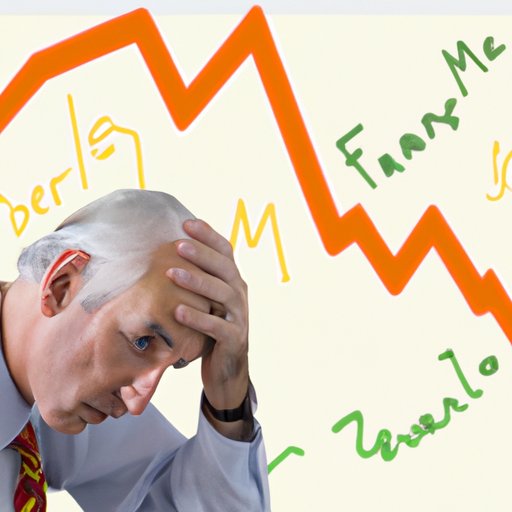Introduction
A financial crisis is a situation in which financial institutions and markets suffer from severe disruption or collapse, resulting in a major economic downturn. The most recent financial crisis began in 2007, when the U.S. housing market collapsed and led to the global recession that lasted until 2009. The causes of this crisis were numerous and complex, and it had drastic effects on the world economy.

Historical Analysis of the Last Financial Crisis and What Can Be Learned From It
The 2007-2009 financial crisis was caused by a combination of factors, including an increase in risky lending practices, overleveraged banks, lax regulation, and inadequate risk management. These factors all led to the near-collapse of the banking system and a massive contraction of the global economy.
The effects of the financial crisis were far-reaching. In the United States alone, 8.8 million jobs were lost, and unemployment rose to 10%. The stock market dropped by more than 50%, while home prices declined by nearly 30%. Globally, the crisis resulted in reduced economic growth and higher levels of poverty.
The financial crisis has taught us many lessons. One of the most important is the need for increased oversight and regulation of the banking industry. Banks must be held accountable for their risky behavior, and regulators must be given the authority to enforce stricter rules and regulations. Additionally, it is essential that banks maintain adequate capital reserves to protect against losses.
Examining the Causes of the Last Financial Crisis
There were several economic factors that contributed to the 2007-2009 financial crisis. One of the primary drivers was the proliferation of subprime mortgages, which enabled people with poor credit histories to obtain mortgages they otherwise would not have qualified for. This led to a rapid increase in home prices, creating an unsustainable bubble.
Another factor was the role of credit rating agencies. These agencies gave overly optimistic ratings to mortgage-backed securities, leading investors to believe they were safe investments. When the value of these securities plummeted, it caused widespread losses.
Finally, the use of derivatives trading played a role in the crisis. Derivatives are complex financial instruments that can amplify losses in times of market volatility. As the housing market began to decline, the value of these derivatives decreased, causing further losses for banks and investors.

Exploring the Current Economic Environment and Whether it Could Lead to Another Financial Crisis
Today, the global economy is facing a number of challenges that could potentially lead to another financial crisis. One of the primary risks is the increasing uncertainty surrounding global trade. With the ongoing trade war between the United States and China, and the potential for other countries to join the fray, there is a risk of a global economic slowdown.
In addition, the rising levels of debt in many countries could be a cause for concern. High levels of debt can make it difficult for governments to respond to economic shocks, which could lead to a financial crisis. Finally, the increasing prevalence of alternative currencies and digital assets could create instability in the global financial system.
Assessing the Role of Government Regulation in Preventing Another Financial Crisis
Since the last financial crisis, governments around the world have taken steps to strengthen their regulatory frameworks. In the United States, the Dodd-Frank Act was passed in 2010, introducing sweeping reforms to the banking system. The act established new regulations for banks and imposed tighter restrictions on their activities, such as limiting their ability to invest in high-risk assets.
Central banks have also been active in trying to prevent another financial crisis. They have implemented a range of measures, such as quantitative easing and interest rate policies, to stimulate the economy and stabilize financial markets.

Investigating How the Banking Sector Has Changed Since the Last Financial Crisis
The banking sector has gone through significant changes since the last financial crisis. Banks have been required to increase their capital requirements, meaning they must hold a certain amount of capital relative to their assets. This helps ensure that banks have enough liquidity to absorb losses if needed.
Regulators have also increased their oversight of banks. Banks are now subject to regular stress tests to evaluate their ability to withstand economic shocks. Additionally, banks are now required to report their activities on a regular basis to ensure compliance with regulations.
Evaluating the Effectiveness of Monetary Policies in Avoiding a New Financial Crisis
Monetary policies, such as quantitative easing and interest rate policies, have been used by central banks to try to avoid a new financial crisis. Quantitative easing, in particular, has been used to inject money into the economy and stimulate growth. However, some economists argue that these policies have been ineffective in preventing a new crisis.
Interest rate policies have also been used to try to avoid a new financial crisis. Central banks have lowered interest rates in order to encourage borrowing and investment. However, low interest rates can also lead to increased risk-taking and reduced savings, which could ultimately lead to a new financial crisis.
Conclusion
The 2007-2009 financial crisis was a devastating event for the global economy, and its effects are still being felt today. Examining the causes of the crisis and the current economic environment can help us assess the potential for another financial crisis. It is clear that governments must continue to strengthen their regulatory frameworks and that banks must be held accountable for their actions. Additionally, central banks must use effective monetary policies to try to avoid a new crisis.
(Note: Is this article not meeting your expectations? Do you have knowledge or insights to share? Unlock new opportunities and expand your reach by joining our authors team. Click Registration to join us and share your expertise with our readers.)
